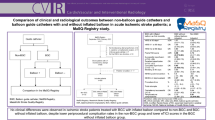Summary
Intra-arterial Nimodipine administration can be an effective alternative to papaverine or balloon angioplasty for the treatment of cerebral vasospasm refractory to medical therapy. It has been used for intractable vasospasm due to aneurysmal subarachnoid haemorrhage (SAH) with convincing results and no significant complications in small case series. This report describes of a patient with symptomatic and angiographically documented vasospasm following traumatic SAH which was refractory to maximal medical therapy and successfully treated with intra-arterial infusion of Nimodipine. This first reported technical note is with special reference to the nimodipine administration modalities, clinical and neuroradiological criteria of selection as well as the follow up of the patient.




Similar content being viewed by others
References
Arakawa Y, Kikuta K, Hojo M, Goto Y, Ishii A, Yamagata S (2001) Milrinone for the treatment of cerebral vasospasm after subarachnoid haemorrhage: report of seven cases. Neurosurgery 48:723–728 discussion 728–730
Biondi A, Ricciardi GK, Puybasset L, Abdennour L, Longo M, Chiras J, Van Effenterre R (2004) Intra-arterial Nimodipine for the treatment of symptomatic cerebral vasospasm after aneurysmal subarachnoid haemorrhage: preliminary results. AJNR Am J Neuroradiol 25:1067–1076
Böker DK, Solymosi L, Wassmann H (1985) Immediate postangiographic intra-arterial treatment of cerebral vasospasm after subarachnoid haemorrhage with nimodipine. Report on 3 cases. Neurochirurgia (Stuttg) 28(Suppl 1):118–120
Clouston JE, Numaguchi Y, Zoarski GH, Aldrich EF, Simard JM, Zitnay KM (1995) Intra-arterial Papaverine infusion for cerebral vasospasm after subarachnoid haemorrhage. AJNR Am J Neuroradiol 16:27–38
Elliott JP, Newell DW, Lam DJ, Eskridge JM, Douville CM, Le Roux PD, Lewis DH, Mayberg MR, Grady MS, Winn HR (1998) Comparison of balloon angioplasty and Papaverine infusion for the treatment of vasospasm following aneurysmal subarachnoid haemorrhage. J Neurosurg 88:277–284
Feng L, Fitzsimmons BF, Young WL, Berman MF, Lin E, Aagaard BD, Duong H, Pile-Spellman J (2002) Intra-arterially administered Verapamil as adjunct therapy for cerebral vasospasm: safety and 2-year experience. AJNR Am J Neuroradiol 23:1284–1290
Firat MM, Gelebek V, Orer HS, Belen D, Firat AK, Balkanci F (2005) Selective intra-arterial Nimodipine treatment in an experimental subarachnoid haemorrhage model. AJNR Am J Neuroradiol 26:1357–1362
Grotenhuis JA, Bettag W, Fiebach BJ, Fiebach BJ, Dabir K (1984) Intra-carotid slow bolus injection of Nimodipine during angiography for treatment of cerebral vasospasm after SAH. A preliminary report. J Neurosurg 61:231–240
Harders A, Kakarieka A, Braakman R (1996) Traumatic subarachnoid haemorrhage and its treatment with Nimodipine: The German tSAH Study Group. J Neurosurg 85:82–89
Hui C, Lau KP (2005) Efficacy of intra-arterial Nimodipine in the treatment of cerebral vasospasm complicating subarachnoid haemorrhage. Clin Rad 60:1030–1036
Langham J, Goldfrad C, Teasdale G, Shaw D, Rowan K (2003) Calcium channel blockers for acute traumatic brain injury. Cochrane Database Syst Rev 4:CD000565
Martin N, Doberstein C, Zane C, Caron MJ, Thomas K, Becker DP (1992) Posttraumatic cerebral arterial spasm: transcranial Doppler ultrasound, cerebral blood flow, and angiographic findings. J Neurosurg 77:575–583
Oertel M, Boscardin WJ, Obrist WD, Glenn TC, McArthur DL, Gravori T, Lee JH, Martin NA (2005) Post-traumatic vasospasm: the epidemiology, severity, and time course of an underestimated phenomenon: a prospective study performed in 299 patients. J Neurosurg 103:812–824
Polin RS, Coenen VA, Hansen CA, Shin P, Baskaya MK, Nanda A, Kassell NF (2000) Efficacy of transluminal angioplasty for the management of symptomatic cerebral vasospasm following aneurysmal subarachnoid haemorrhage. J Neurosurg 92:284–290
Rosenwasser RH, Armonda RA, Thomas JE, Benitez RP, Gannon PM, Harrop J (1999) Therapeutic modalities for the management of cerebral vasospasm: timing of endovascular options. Neurosurgery 44:975–978
Sander D, Klingelhofer J (1993) Cerebral vasospasm following post-traumatic subarachnoid haemorrhage evaluated by transcranial Doppler ultrasonography. J Neurol Sci 119:1–7
Terada T, Kinoshita Y, Yokote H, Tsuura M, Nakai K, Itakura T, Hyotani G, Kuriyama T, Naka Y, Kido T (1997) The effect of endovascular therapy for cerebral arterial spasm, its limitations and pitfalls. Acta Neurochir 139:227–234
Vajkoczy P, Horn P, Bauhuf C, Munch E, Hubner U, Ing D, Thome C, Poeckler-Schoeninger C, Roth H, Schmiedek P (2001) Effect of intra-arterial Papaverine on regional blood flow in haemodynamically relevant cerebral vasospasm. Stroke 32:498–505
Author information
Authors and Affiliations
Corresponding author
Additional information
Comments
Positive response of intra-arterial nimodipine (IAN) administration on severe cerebral vasospasm after aneurysmal SAH was demonstrated with additional correlation to cerebral perfusion (1). Conti et al. report here a case with IAN administration on traumatic SAH associated medically refractory vasospasm and could demonstrate both the technical feasibility and clinical effectiveness.
References
1. Hänggi D., Turowski B, Beseoglu K, Yong M, Steiger HJ (2008) Intra-arterial nimodipine for severe cerebral vasospasm after aneurysmal subarachnoid haemorrhage: influence on clinical course and cerebral Perfusion. AJNR 29: 1053–60
Michael Synowitz
Department of Neurosurgery
Charité-Universitätsmedizin Berlin
Germany
Comment
Authors report the case of a patient with symptomatic and angiographically documented vasospasm following traumatic SAH and was refractory to maximal medical therapy, but was successfully treated with intra-arterial infusion of nimodipine. Technical notes from this first case are described and reported with clinical and neuroradiological criteria for patient selection.
It is well-known that subarachnoid haemorrhage induced cerebral vasospasm complicates the treatment of patients with severe head injury. Similarly to patients with aneurysmal subarachnoid haemorrhage, the vasospasm initiates the third post-injury day with a peak occurrence from 7 to 12 days. Even though it is accepted that decreased cerebral blood flow and clinical deterioration can be the result of the vasospasm, this is the first reported head injured patient in which clinical symptoms definitely correlated with angiography, cerebral blood flow velocity (TCD) and cerebral blood flow (SPECT) documented vasospasm. The only concern is that based on clinical history and CT images the aneurysmal origin of the vasospasm cannot be 100% excluded, especially since 15–20% of SAH cases the angiography is unable to show the bleeding source (aneurysm).
P. Barzo
Albert Szent-Gyorgyi Medical University
Hungary
Rights and permissions
About this article
Cite this article
Conti, A., Angileri, F.F., Longo, M. et al. Intra-arterial nimodipine to treat symptomatic cerebral vasospasm following traumatic subarachnoid haemorrhage. Technical case report. Acta Neurochir (Wien) 150, 1197–1202 (2008). https://doi.org/10.1007/s00701-008-0141-0
Received:
Accepted:
Published:
Issue Date:
DOI: https://doi.org/10.1007/s00701-008-0141-0




